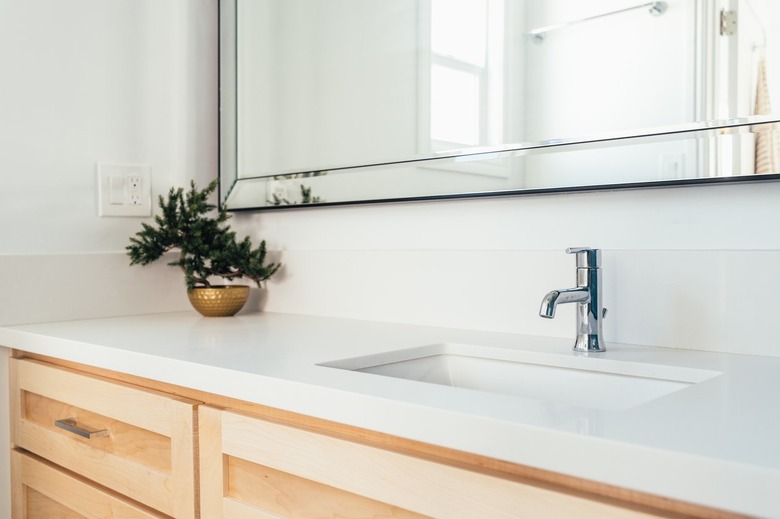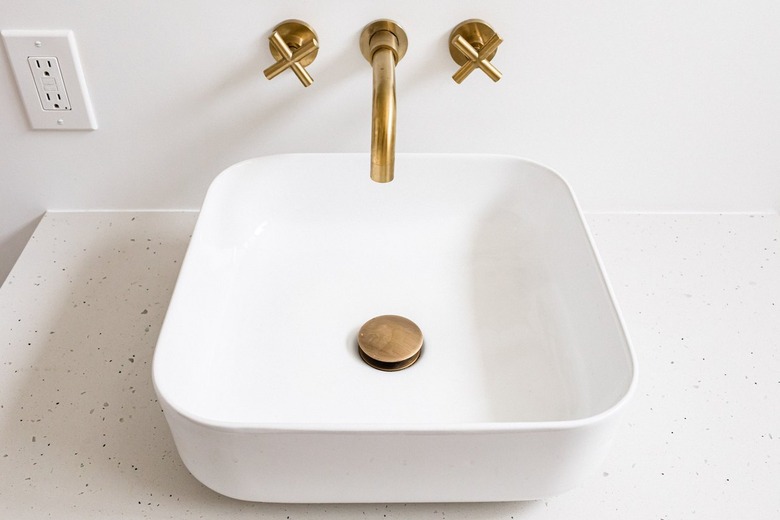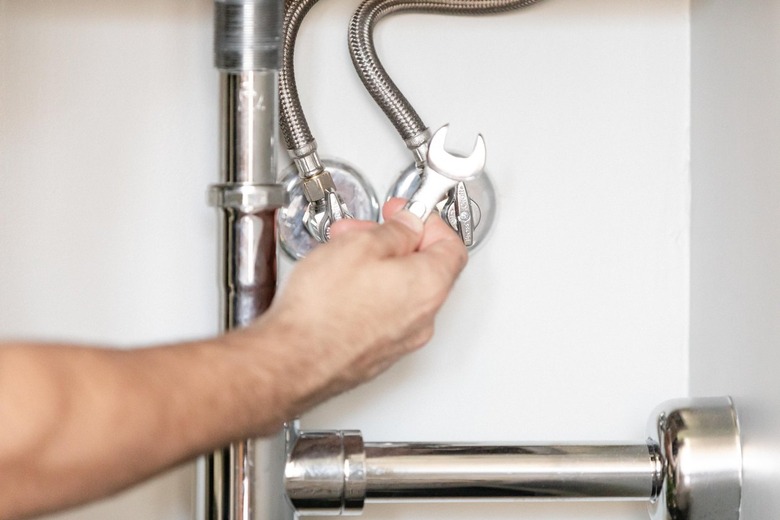9 Reasons Why Your Sink Is Leaking
We may receive a commission on purchases made from links.
You're about to start washing dishes when you open the cabinet under the sink to grab a new sponge and discover a puddle of water. Is it a faucet leak, a clogged P-trap, a loosened supply line, a leaky drain, or something else?
While some people immediately resort to calling a plumber, many problems are simple enough to fix yourself. Knowing the most common reasons for sink leaks can help you determine whether you should try a DIY approach or if it's time to hire a professional plumber instead. Of course, if your sink continues to leak after your repair, be sure to call a plumber as soon as possible.
1. A Leaking Faucet
1. A Leaking Faucet
Leaks coming from the faucet typically result in puddles appearing on the sink when you turn on the water, but occasionally, they may appear under the sink. Most faucet leaks are caused by worn-out hardware inside the faucet. Depending on your faucet type, fixing these issues may be simple or may require a plumber. Leaks in compression (two-handled faucet that you tighten and loosen to turn the water off and on) and cartridge faucets (generally a one-handled faucet where you adjust water temperature) are good DIY projects, but because ball-type faucets are so complex and have so many moving parts, they are best repaired by a plumber. On the other hand, ceramic disk faucets are so simple that they almost never have issues, so when they do, it's usually something that requires professional knowledge.
Before fixing a faucet, take time to evaluate its condition. If it has any corrosion or rust, the whole faucet should be replaced, which is a DIY project that simply requires removing the old faucet and following the new faucet's installation instructions.
2. A Failed Seat Washer
2. A Failed Seat Washer
In compression faucets, the most common reasons for leaks are a failed seat washer, O-ring, or valve seat. To attempt a DIY repair, use the shutoff valves to turn off the hot and cold water supply lines and then turn the faucet on to drain the remaining water from the lines.
Next, use a screwdriver to remove the decorative caps hiding the screws on the handles and remove the screw to take it off. Unscrew the packaging nut using a crescent wrench and loosen the stem (the vertical piece underneath the handle) from the faucet body with an adjustable wrench. Then, take the rubber washer off the end of the stem and replace it with a new seat washer of the same size that has been coated in plumbers' grease.
3. An Old Compression Faucet O-Ring
3. An Old Compression Faucet O-Ring
To replace an O-ring, simply remove the stem from the packing nut and then replace the O-ring inside, coating the new part in plumbers' grease before putting everything back in place. Be sure to always use an O-ring of the same size to avoid further leaks.
4. A Corroded Valve Seat
4. A Corroded Valve Seat
Occasionally, the problem in compression faucets is a corroded valve seat (the part that connects the spout to the tap), which becomes corroded when water accumulates around it. While it's possible to replace the seat washer or O-ring yourself, a valve seat is best repaired by a plumber.
5. A Damaged Cartridge Faucet
5. A Damaged
Cartridge Faucet
In cartridge faucets (aka one-handled faucets) the most common reason for a leak is an old and worn out O-ring or a damaged cartridge, both of which sit just underneath the handle. To attempt a repair, shut off your water supply lines and turn on the faucet to let the remaining water run out. Remove the decorative cap on the handle that hides the screw and then unscrew and remove the handle. Some models use a threaded retaining clip to hold the cartridge in place; this can be removed using needle-nose pliers.
Replace the cartridge with a cartridge of the exact same type and in the same size. Insert the cartridge back in place of the original cartridge and then reassemble the faucet the same way you disassembled it.
To replace the O-ring, pull the cartridge straight up and out of the faucet and locate the O-ring just underneath it. Replace the cartridge and O-ring using parts of the exact same size to avoid further leaks. Before putting the new O-ring in place, coat it with plumbers' grease.
6. Drippy Water Supply Lines
6. Drippy Water Supply Lines
If the leak occurs even when you're not using the sink, you could have a problem with the water supply connection. Most sinks have two water supply connections, one for hot water and one for cold, but a kitchen faucet may have a third line that connects to the sprayer. Any of these connections could leak as a result of a loose connection, a break in the line, or a failed seal in the compression nut.
To fix the issue, shut off the water supply and drain the water from the lines by turning on the faucet. Next, try tightening the connections. If you were able to tighten any significantly, turn the water back on and test if the leak is still happening.
If water is still leaking, try replacing the whole supply line with a new one, making sure to fully tighten the connections. Turn on your water supply lines again and see if the leak has stopped. If you still notice a leak, call a professional since the issue could be corrosion in the compression fittings or pipes.
7. A Leaking Sink Drain
7. A Leaking Sink Drain
To test if you have a drain leak, plug up the sink, fill it all the way, and unplug it. Then, shine a flashlight under the drain to see if you see any drips forming. If the water drips along the nuts where the pipes meet, try tightening the nuts.
Otherwise, the most common cause of drain leaks is that the plumbers' putty that is sealing the drain assembly in place has started to dry out. In this case, remove the drain, put in fresh plumbers' putty, and reinstall the drain assembly. When your drain is out, take time to inspect it. If it has any blockage, corrosion, or rust, buy and install a new drain assembly instead.
8. A Clogged P-Trap
8. A Clogged P-Trap
The P-trap is the large curve in the drain pipe that prevents sewage smells from entering your home. When P-traps get plugged, they back up with water, which may drip from fittings in the pipe. While P-trap leaks aren't always stinky, if a sink leak emits a foul stench, the P-trap is probably clogged. You can unclog the P-trap with a plunger to break up the remaining debris before it causes more clogs. If the sink continues to be clogged, you may need professional plumber services to clear the drain.
If your P-trap has any rust, corrosion, or cracks or is just broken, you will need to replace the pipes. In most cases, this simply requires installing a new P-trap in place of the old one but be warned that it is a dirty job, especially when the pipes are clogged. If you have any trouble removing corroded or rusted old pipes, call a plumber so you do not risk damaging the remaining pipes.
9. Clogged Sewage Pipes
9. Clogged Sewage Pipes
While the cause of a kitchen or bathroom sink leak is rarely caused by a problem in the sewage lines, just as a clog in a P-trap can cause a leak, water can also occasionally leak when backed up behind a clogged sewage line. This is not an issue that should be handled by an amateur. If you suspect a problem with your sewage pipes, call a professional plumber immediately.


